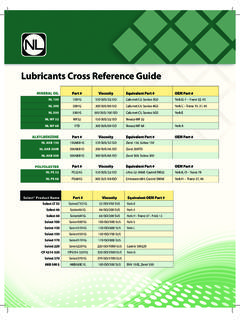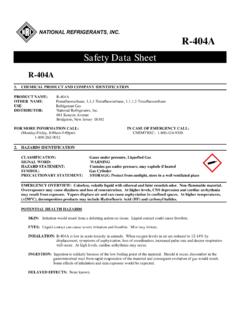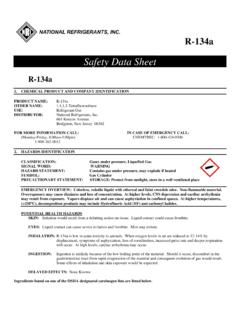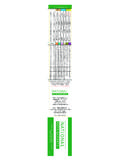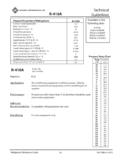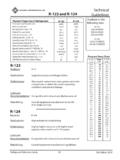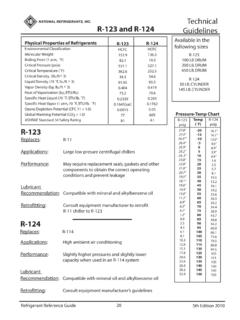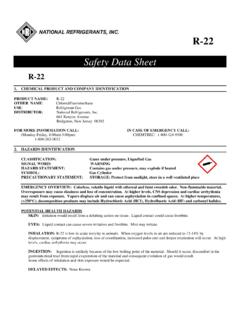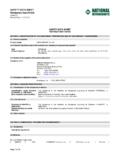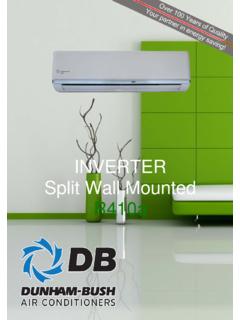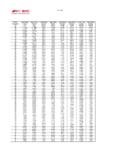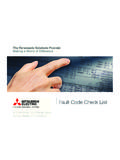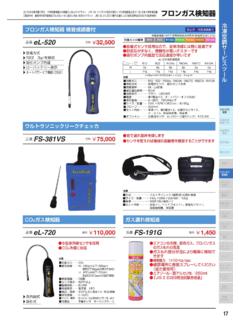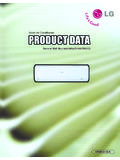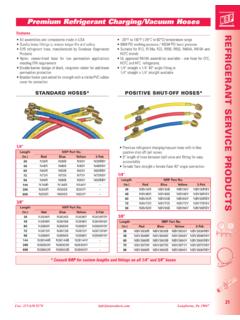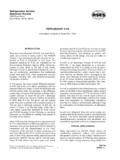Transcription of R-410A - Refrigerants
1 R- 410a . Safety Data Sheet R- 410a . 1. CHEMICAL PRODUCT AND COMPANY IDENTIFICATION. PRODUCT NAME: R- 410a . OTHER NAME: Difluoromethane, Pentafluoroethane USE: Refrigerant Gas DISTRIBUTOR: National Refrigerants , Inc. 661 Kenyon Avenue Bridgeton, New Jersey 08302. FOR MORE INFORMATION CALL: IN CASE OF EMERGENCY CALL: (Monday-Friday, 8:00am-5:00pm) CHEMTREC: 1-800-424-9300. 1-800-262-0012. 2. HAZARDS IDENTIFICATION. CLASSIFICATION: Gases under pressure, Liquefied Gas SIGNAL WORD: WARNING. HAZARD STATEMENT: Contains gas under pressure, may explode if heated SYMBOL: Gas Cylinder PRECAUTIONARY STATEMENT: STORAGE: Protect from sunlight, store in a well ventilated place EMERGENCY OVERVIEW: Colorless, volatile liquid with ethereal and faint sweetish odor.
2 Non-flammable material. Overexposure may cause dizziness and loss of concentration. At higher levels, CNS depression and cardiac arrhythmia may result from exposure. Vapors displace air and can cause asphyxiation in confined spaces. At higher temperatures, (>250 C), decomposition products may include Hydrofluoric Acid (HF) and carbonyl halides. POTENTIAL HEALTH HAZARDS. SKIN: Irritation would result from a defatting action on tissue. Liquid contact could cause frostbite. EYES: Liquid contact can cause severe irritation and frostbite. Mist may irritate. INHALATION: R- 410a is low in acute toxicity in animals.
3 When oxygen levels in air are reduced to 12-14% by displacement, symptoms of asphyxiation, loss of coordination, increased pulse rate and deeper respiration will occur. At high levels, cardiac arrhythmia may occur. INGESTION: Ingestion is unlikely because of the low boiling point of the material. Should it occur, discomfort in the gastrointestinal tract from rapid evaporation of the material and consequent evolution of gas would result. Some effects of inhalation and skin exposure would be expected. DELAYED EFFECTS: None known. R- 410a . 3. COMPOSITION / INFORMATION ON INGREDIENTS.
4 INGREDIENT NAME CAS NUMBER WEIGHT %. Difluoromethane 75-10-5 50. Pentafluoroethane 354-33-6 50. COMMON NAME and SYNONYMS. R- 410a ; HFC410A. There are no impurities or stabilizers that contribute to the classification of the material identified in Section 2. 4. FIRST AID MEASURES. SKIN: Promptly flush skin with water until all chemical is removed. If there is evidence of frostbite, bathe (do not rub). with lukewarm (not hot) water. If water is not available, cover with a clean, soft cloth or similar covering. Get medical attention if symptoms persist. EYES: Immediately flush eyes with large amounts of water for at least 15 minutes (in case of frostbite water should be lukewarm, not hot) lifting eyelids occasionally to facilitate irrigation.
5 Get medical attention if symptoms persist. INHALATION: Immediately remove to fresh air. If breathing has stopped, give artificial respiration. Use oxygen as required, provided a qualified operator is available. Get medical attention. Do not give epinephrine (adrenaline). INGESTION: Ingestion is unlikely because of the physical properties and is not expected to be hazardous. Do not induce vomiting unless instructed to do so by a physician. ADVICE TO PHYSICIAN: Because of the possible disturbances of cardiac rhythm, catecholamine drugs, such as epinephrine, should be used with special caution and only in situations of emergency life support.
6 Treatment of overexposure should be directed at the control of symptoms and the clinical conditions. 5. FIRE FIGHTING MEASURES. FLAMMABLE PROPERTIES. FLASH POINT: Gas, not applicable per DOT regulations FLASH POINT METHOD: Not applicable AUTOIGNITION TEMPERATURE: >750 C. UPPER FLAME LIMIT (volume % in air): None by ASTM D-56-82. LOWER FLAME LIMIT (volume % in air): None by ASTM E-681. FLAME PROPAGATION RATE (solids): Not applicable OSHA FLAMMABILITY CLASS: Not applicable EXTINGUISHING MEDIA: Use any standard agent choose the one most appropriate for type of surrounding fire (material itself is not flammable).
7 _____. MSDS: R- 410a Page 2 of 8. Current Issue Date: April, 2015. R- 410a . UNUSUAL FIRE AND EXPLOSION HAZARDS: R- 410a is not flammable at ambient temperatures and atmospheric pressure. However, this material will become combustible when mixed with air under pressure and exposed to strong ignition sources. Contact with certain reactive metals may result in formation of explosive or exothermic reactions under specific conditions ( very high temperatures and/or appropriate pressures). SPECIAL FIRE FIGHTING PRECAUTIONS/INSTRUCTIONS: Firefighters should wear self-contained, NIOSH-approved breathing apparatus for protection against possible toxic decomposition products.
8 Proper eye and skin protection should be provided. Use water spray to keep fire-exposed containers cool. 6. ACCIDENTAL RELEASE MEASURES. IN CASE OF SPILL OR OTHER RELEASE: (Always wear recommended personal protective equipment.). Evacuate unprotected personnel. Product dissipates upon release. Protected personnel should remove ignition sources and shut off leak, if without risk, and provide ventilation. Unprotected personnel should not return to the affected area until air has been tested and determined safe, including low-lying areas. Spills and releases may have to be reported to Federal and/or local authorities.
9 See Section 15 regarding reporting requirements. 7. HANDLING AND STORAGE. NORMAL HANDLING: (Always wear recommended personal protective equipment.). Avoid breathing vapors and liquid contact with eyes, skin or clothing. Do not puncture or drop cylinders, expose them to open flame or excessive heat. Use authorized cylinders only. Follow standard safety precautions for handling and use of compressed gas cylinders. R- 410a should not be mixed with air above atmospheric pressure for leak testing or any other purpose. STORAGE RECOMMENDATIONS: Store in a cool, well-ventilated area of low fire risk and out of direct sunlight.
10 Protect cylinder and its fittings from physical damage. Storage in subsurface locations should be avoided. Close valve tightly after use and when empty. INCOMPATIBILITIES: Freshly abraded aluminum surfaces at specific temperatures and pressures may cause a strong exothermic reaction. Chemically reactive metals: potassium, calcium, powdered aluminum, magnesium, and zinc. 8. EXPOSURE CONTROLS / PERSONAL PROTECTION. ENGINEERING CONTROLS: Provide local ventilation at filling zones and areas where leakage is probable. Mechanical (general) ventilation may be adequate for other operating and storage areas.
